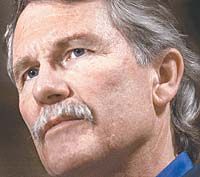forum
library
tutorial
contact

Kitzhaber: Consider Breaching River Dams
by Dan Hansen & Jonathan MartinThe Spokesman Review, May 1, 2002
|
the film forum library tutorial contact |

|
Kitzhaber: Consider Breaching River Damsby Dan Hansen & Jonathan MartinThe Spokesman Review, May 1, 2002 |
Current salmon-saving strategy just as costly, governor says
 Oregon's governor on Tuesday said breaching Snake River dams is too "cost-effective" as a salmon-saving strategy to be dismissed.
Oregon's governor on Tuesday said breaching Snake River dams is too "cost-effective" as a salmon-saving strategy to be dismissed.
"If we look at the political trade-offs involved, and the other choices involved, breaching is every bit as desperate and cost-effective as other options," Gov. John Kitzhaber told attendees of a conference on the Columbia River ecosystem.
While he called the cheap power generated by the region's dams a "tremendous asset" to the Northwest, he said the cost of breaching Washington's four Snake River dams would be only slightly more than current long-term plans to save salmon habitat.
Kitzhaber, a Democrat, also criticized the Bush administration for failing to fully fund those plans.
The administration budgeted slightly more than half of the $900 million plan, a decision that amounts to "mortgaging the legacy of our children and grandchildren for a short-term benefit," Kitzhaber said.
He spoke on the fourth day of a five-day Spokane Convention Center conference attended by more than 700 people from Northwestern states and British Columbia. Most are biologists or managers from biological agencies. Others are members of citizens groups, like the Lake Roosevelt Forum, and tribal members.
An informal survey at the conference showed concern that environmental conditions in the Columbia Basin are getting worse.
Of the 61 attendees who responded, 47 percent said the environmental health of the ecosystem is getting worse. Twenty-eight percent said it's getting better, and 26 percent said it's holding its own.
Breaching the dams is an unlikely prospect, at least in the near future. Though environmental groups and some Indian tribes continue to push for breaching, federal agencies consider it a last resort, if wild fish populations can't be improved.
Although conference attendees have been discussing a broad range of river-related issues, salmon are the primary focus.
The conference was designed to build trust between various groups and break down barriers to improving river conditions, said John Harrison, spokesman for the Northwest Power Planning Council.
Asked by conference organizers to list some of those barriers, many said that funding for salmon recovery is insufficient and uncertain.
Other concerns included an oversimplification of issues by the media and the perception that fish managers are forcing communities to choose between jobs and the environment.
Lunch speakers on Monday and Tuesday represented the extremes in outlook.
Bob Lohn, Northwest head of the National Marine Fisheries Service, said Tuesday that he's optimistic about the fish's future.
Conditions in the Pacific Ocean off the Northwest coast turned from poor to good during recent years, and that trend is likely to continue for at least 10 years, Lohn said.
Meanwhile, scientists are continually learning more about the needs of salmon.
And communities along salmon spawning streams are showing "a level of interest and involvement that I'm delighted to see and wouldn't have guessed existed," Lohn said.
John Andrews, regional head of the Washington Department of Fish and Wildlife, said he shares Lohn's enthusiasm.
"We're putting water back in the streams. We're improving the buffers (between streams and developments). We're making changes," said Andrews, who is based in Spokane.
"There is a belief that we can turn this salmon recovery around."
But Robert Lackey, a fisheries biologist for the U.S. Environmental Protection Agency, gave a pessimistic report Monday.
While wild salmon are unlikely to disappear from the Northwest entirely, they will probably hang onto existence in low numbers, in only a small portion of their original range, Lackey said.
"Billions of dollars have been spent in a so-far failed attempt to reverse the long-term slide of wild salmon," with some runs gone and others reduced to less than 10 percent of their historic populations, Lackey said.
Meanwhile, the Northwest's human population continues to grow, putting greater strains on the environment.
The population will quadruple by 2100 if the current growth rate continues, said Lackey, who suggested the best hope for saving any wild salmon -- as opposed to those raised in hatcheries -- is to improve conditions on coastal streams.
Related Sites:
2001 Progress Report
learn more on topics covered in the film
see the video
read the script
learn the songs
discussion forum
